Decolonisation of Asia
The decolonization of Asia was the gradual growth of independence movements on the Asian continent, leading ultimately to the retreat of foreign powers and the creation of a number of nation-states in the region. A number of events were catalysts for this shift, most importantly the Second World War. Prior to World War II, some countries such as the Philippines during 1898 had proclaimed independence from Spain. The first state to be de-colonised was the Philippines in 1898, and the last was Macau in 1999.
Background
European powers began colonizing Asia in the early 16th century, beginning with the Portuguese seizure of sites along the west coast of India, Ceylon and Malacca. In 1511, Portugal established a permanent base in Malacca. In 1565, Spain commenced its colonization of the Philippine Islands, creating a long sea trade route via Mexico to Spain.
The decline of Spain and Portugal in the 17th century paved the way for other European powers, namely the Netherlands, France and England. Portugal would lose influence in all but three of its colonies, Portuguese India, Macau and Timor.
By the end of the 17th century, the Dutch had taken over much of the old Portuguese colonies, and had established a strong presence in present-day Indonesia, with colonies in Aceh, Bantam, Makassar and Jakarta. The Dutch also had trade links with Siam, Japan, China and Bengal.
The British had competed with Portuguese, Spanish and Dutch for their interests in Asia since the early 17th century, and by the mid-19th century held much of India (via the British East India Company), as well as Burma, Ceylon, Malaya and Singapore. After India's First War of Independence of 1857, Queen Victoria was declared Empress of India, thus solidifying the British rule on the subcontinent. The last British acquisition in Asia was the New Territories of Hong Kong, which was leased from the Qing emperor in 1897, expanding the British colony originally ceded in the Treaty of Nanking in 1842.
The French had little success in India following defeats against the British in the 17th century, though they held onto possessions on the east coast of India (such as Pondicherry and Mahar) until decolonisation. The French established their most lucrative and substantial colony in Indochina from 1862, eventually occupying the present-day areas of Vietnam, Laos, and Cambodia by 1887.
Japan's first colony was the island of Taiwan, occupied in 1874 and officially ceded by the Qing emperor in 1894. Japan continued its early imperialism with the annexation of Korea in 1910.
The United States entered the region in 1898 during the Spanish–American War, taking the Philippines as its sole colony through a mock battle in the capital and the purchase of the Philippines from Spain after the declaration of independence and the First Philippine Republic.
Asian colonies from the 19th century to the end of the Second World War
The following list shows the colonial powers following the end of hostilities in 1945, and their colonial or administrative possessions.
 France:
France:
- French India (1954)
 Vietnam (1945)
Vietnam (1945) Cambodia (1953)
Cambodia (1953) Laos (1953)
Laos (1953)
 Portugal:
Portugal:
- Portuguese India (1961)
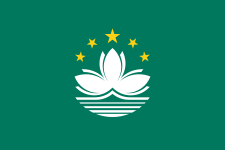 Macau (1999)
Macau (1999)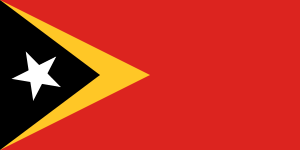 Timor-Leste (1975/2002)
Timor-Leste (1975/2002)
 Spain:
Spain:
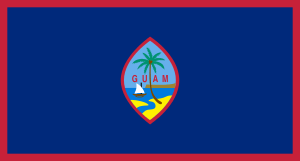 Guam (1898)
Guam (1898)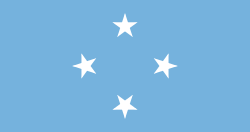 F.S. Micronesia (1899)
F.S. Micronesia (1899) Northern Mariana Islands (1899)
Northern Mariana Islands (1899)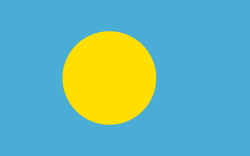 Palau (1899)
Palau (1899) Philippines (1898)
Philippines (1898)
 Netherlands:
Netherlands:
 Indonesia (1949)
Indonesia (1949)- Netherlands New Guinea (1962)
 Soviet Union:
Soviet Union:
 North Korea (1948)
North Korea (1948)
 Australia:
Australia:
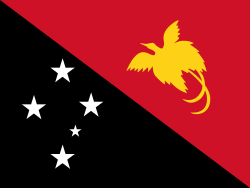 Papua New Guinea (1975)
Papua New Guinea (1975)
 United States:
United States:
 Philippines (1946)
Philippines (1946) South Korea (1948)
South Korea (1948)
The United States and the Soviet Union both occupied Korea, splitting the country approximately in half.
Individual countries
Burma
See Burma's colonial era.
Burma was almost completely occupied by the Imperial Japanese Army during the Second World War. Many Burmese fought alongside Japan in the initial stages of the war, though the Burmese Army and most Burmese switched sides in 1945.
A transitional government sponsored by the British government was formed in the years following the Second World War, ultimately leading to Burma's independence in January 1948.
Cambodia
See Cambodia's passage to independence.
Following the capitulation of France and the formation of the Vichy regime, France's Indochinese possessions were given to Japan. While there was some argument that Indochina should not be returned to France, particularly from the United States, Cambodia nevertheless remained under French rule after the end of hostilities.
France had placed Norodom Sihanouk on the throne in 1941, and were hoping for a puppet monarch. They were mistaken however, as the King led the way to Cambodian independence in 1953, taking advantage of the background of the First Indochina War being fought in Vietnam.
Ceylon
Ceylon was an important base of operations for the Western Allies during the Second World War. The British gave in to popular pressure for independence and in February 1948, the country won its independence as the Dominion of Ceylon.
Hong Kong
Hong Kong was returned to the United Kingdom following its occupation by the Japanese during the Second World War. It was controlled directly by a British governor until the expiry of the hundred-year lease, which occurred in 1997. From that date the territory was controlled as a Special Administrative Region of the People's Republic of China.
Philippines
The Philippines unilaterally declared independence from Spain on 12 June 1898 under the leadership of President Emilio Aguinaldo, culminating the 1896 Revolution. Unbeknownst to the newly established government and the Filipino people in general, the United States of America had secretly arranged to purchase the colony along with several other possessions from Spain through the Treaty of Paris that concluded the Spanish–American War. After staging a mock battle in Manila, the Philippine–American War ensued until the Philippine government capitulated in 1902.
The Philippines subsequently underwent successive stages of rule under the United States, first as an unincorporated territory, then as a Commonwealth. It was then occupied by the Japanese during the Second World War and, after the Allied victory in 1945, granted full independence by the United States on 4 July 1946.
Timeline
The "colonial power" and "colonial name" columns are merged when required to denote territories, where current countries are established, that have not been de-colonised, but achieved independence in different ways.
| Country[1] | Colonial name | Colonial power[2] | Independence declared[3] | First head of state[4] | War for independence |
| Japan | Establishment under the first Legendary Emperor | 11 February 660 BC | Emperor Jimmu | - | |
| Thailand | Establishment as the Kingdom of Sukhothai | 1238 | Sri Indraditya | - | |
| Turkey | Established in Anatolia of the Byzantine Empire | 1299[5] | Osman I | Byzantine–Ottoman Wars | |
| China[6] | Overthrow of Mongol rule over China | 23 January 1368[7] | Hongwu Emperor | Red Turban Rebellion | |
| Russia | Duchy of Moscow terminates Mongol vassalage | 8 September 1380 | Dmitry of Moscow | Battle of Kulikovo | |
| Iran | Establishment under the Safavid dynasty | 1502 | Ismail I | - | |
| Bhutan | Establishment as the Kingdom of Bhutan | 1616 | Ngawang Namgyal | - | |
| Nepal | Unification as the Kingdom of Nepal | 21 December 1768 | Prithvi Narayan | - | |
| Saudi Arabia | Arabia | Ottoman | 1824 | Turki bin Abdullah bin Muhammad | Reconquest of Riyadh |
| Yemen[8] | Kingdom of Yemen Colony and Protectorate of Aden |
Ottoman Britain |
1 November 1918 30 November 1967 |
Yahya I Qahtan Mohammed al-Shaabi |
World War I Aden Emergency |
| Afghanistan | Afghanistan | Britain | 19 August 1919 | Amānullāh Khān | Third Anglo-Afghan War |
| Mongolia | Outer Mongolia | China | 9 July 1921 | Bogd Khan | Outer Mongolian Revolution |
| Iraq | Mesopotamia mandate | Ottoman; Britain | 3 October 1932 | Faisal I | Iraqi revolt against the British |
| Lebanon | Lebanon mandate | Ottoman; France | 8 November 1943 | Bechara Khoury | - |
| Syria | Syria mandate | Ottoman; France | 30 November 1943 | Shukri al-Quwatli | Syrian Revolution |
| Jordan | Transjordan mandate | Ottoman; Britain | 25 May 1946 | Abdullah I | - |
| Philippines | Commonwealth of the Philippines | Spain; USA | 4 July 1946 | Manuel Roxas | -[9] |
| Pakistan | British India (part) | Britain | 14 August 1947[10] | Muhammad Ali Jinnah | -[11] |
| India | British India (part) | Britain | 15 August 1947[12] | Jawaharlal Nehru | -[13] |
| Burma | Burma | Britain | 4 January 1948 | Sao Shwe Thaik | - |
| Sri Lanka | Dominion of Ceylon | Britain | 4 February 1948 | Don Senanayake | - |
| Israel | Palestine mandate | Ottoman; Britain | 14 May 1948 | David Ben-Gurion | 1948 Palestine war |
| South Korea | Korea | Japan | 15 August 1948[14] | Rhee Syung-man | Division of Korea in World War II |
| North Korea | Korea | Japan | 9 September 1948[14] | Kim Tu-bong | Division of Korea in World War II |
| Indonesia[15] | Netherlands East Indies | Netherlands | August 17, 1945[16] | Sukarno | Indonesian National Revolution |
| Egypt[17] | Egypt | Britain | 1922/1936/1953 | n/a | Urabi Revolt, Suez Crisis |
| Cambodia | French Indochina | France | 17 October 1953 | Norodom Sihanouk | - |
| Laos | French Indochina | France | August 1, 1954 | Sisavang Vong | First Indochina War |
| Vietnam[18] | French Indochina | France | August 1, 1954 | Hồ Chí Minh Bảo Đại |
First Indochina War |
| Malaysia | Malaya Sabah, Sarawak |
Britain | 31 August 1957 16 September 1963 |
Tuanku Abdul Rahman | -[19] |
| Cyprus | Cyprus | Britain | August 16, 1960 | Makarios III | -[20] |
| Kuwait | Kuwait | Britain | 19 June 1961 | Abdullah III Al-Salim Al-Sabah | - |
| Oman | Muscat, Oman Muscat and Oman[21] |
Portugal Britain |
January 26, 1650 1962 |
Sultan I bin Saif Said bin Taimur |
Night attack on Muscat -[22] |
| Singapore | Singapore | Britain | August 31, 1963[23] | Yusof bin Ishak | - |
| Maldives | Maldives | Britain | 26 July 1965 | Muhammad Fareed Didi | - |
| Bangladesh | East Pakistan | Britain; Pakistan | 16 December 1971 | Bangabandhu Sheikh Mujibur Rahman | Bangladesh Liberation War |
| Qatar | Qatar | Britain | 3 September 1971 | Ahmad bin Ali Al Thani | - |
| United Arab Emirates | Trucial States | Britain | 2 December 1971[24] | Zayed bin Sultan Al Nahyan | - |
| Bahrain | Bahrain | Britain | 16 December 1971 | Isa ibn Salman Al Khalifa | -[25] |
| Brunei | Brunei | Britain | 1 January 1984 | Hassanal Bolkiah | -[26] |
| Timor-Leste[27] | Portuguese Timor; Timor Timur |
Portugal; Indonesia |
November 28, 1975; May 20, 2002[28] |
Francisco Xavier do Amaral; Xanana Gusmão |
Carnation Revolution; Indonesian occupation |
| Palestine[29]</ref> | Palestine mandate; Occupied Palestinian Territories[38] |
Ottoman; Britain; Israel |
May 15, 1948; independence not yet effectuated[30] |
?; Mahmoud Abbas |
1948 Palestine war; Israeli–Palestinian conflict |
See also
- United Nations list of Non-Self-Governing Territories
- List of dependent territories
- Colonialism
- Imperialism in Asia
- Taiwan under Japanese rule
- Decolonisation
- Wars of national liberation
Notes
- ↑ Timeline list arranged according to current countries. Explanatory notes are added in cases where decolonization was achieved jointly or where the current state is formed by merger of previously decolonized states.
- ↑ Some territories changed hands multiple times, so in the list is mentioned the last colonial power. In addition to it the mandatory or trustee powers are mentioned for territories that were League of Nations mandates and United Nations trust territories.
- ↑ Date of decolonization. Dates for territories annexed by or integrated into previously decolonized independent countries are given in separate notes. Subsequent mergers, secessions and civil and other wars in the period after decolonization and the resulting states and federations are not part of this list - see the list of sovereign states by formation date.
- ↑ First head of state after independence. For current and former Commonwealth realms instead of first head of state is listed the first head of government.
- ↑ Turkey succeeded the Ottoman Empire on 24 July 1923 following the Turkish War of Independence against the some of the Entente Powers of World War I.
- ↑ After the overthrow of Mongol rule China was organized under the Ming Dynasty, to be succeeded by the Qing Dynasty, then by the Republic of China and that is competing to present day with the People's Republic of China.
- ↑ China has endured many modifications to its territory. Some of these include the establishment of small foreign concessions and colonies by European states (Austria-Hungary, Belgium, Britain, Germany, France, Italy, Portugal, Russia), Japan (including larger territories like Manchukuo) and the United States. The last of these territories, Hong Kong and Macau were returned to Chinese sovereignty in 1997 and 1999 by Britain and Portugal respectively. Because of the Chinese Civil War since 1 October 1949 there are two competing governments of China - one with de facto control over the island of Taiwan (RoC) and the other - over the mainland (PRC).
- ↑ North Yemen and South Yemen were unified into the Republic of Yemen on May 22, 1990.
- ↑ In the 1896-19 period there were the Philippine Revolution and Philippine–American War Prior to American invasion and annexation, the country declared independence from Spain during 1898.
- ↑ As the Dominion of Pakistan.
- ↑ See Pakistan Movement.
- ↑ Subsequently, a free and sovereign India unilaterally annexed Hyderabad State from a local ruler in 1948 and Goa from Portugal in 1961; Puducherry was ceded by France in 1954.
- ↑ See Indian independence movement and Goa liberation movement.
- ↑ 14.0 14.1 The Korea peninsula was liberated from Japan on August 15, 1945. The southern half was put under United States administration until August 15, 1948. The northern half was put under Soviet administration until 9 September 1948.
- ↑ Transcontinental country, partially located in Oceania.
- ↑ Netherlands New Guinea was separated from the Dutch East Indies on 29 December 1950. Following skirmishes with Indonesia in 1961 and the New York Agreement, the Netherlands transferred authority of Dutch New Guinea to a UN protectorate on 1 October 1962 and it was integrated into Indonesia on 1 May 1963.
- ↑ Transcontinental country, partially located in Africa.
- ↑ North Vietnam proclaimed independence on September 2, 1945 as the Democratic Republic of Vietnam. The State of Vietnam declared independence on June 14, 1949, but remained de facto under French rule until August 1, 1954. South Vietnam was the successor state to the State of Vietnam under the name of Republic of Vietnam. Both parts of Vietnam merged into the Socialist Republic of Vietnam on April 30, 1975, after the Vietnam War.
- ↑ The Malayan Communist Party fought in the Malayan Emergency between June 1948 – 12 July 1960.
- ↑ Armed struggles by the EOKA (Greek) and TMT (Turkish) organizations.
- ↑ Muscat and Oman was de facto a British protectorate. On June 4, 1856, the Sultan who ruled from Stone Town, Zanzibar, died without appointing an heir. With British intervention on April 6, 1861, Zanzibar and Oman were divided into two separate principalities. Zanzibar later became a formal British protectorate, but the British influence over Muscat and Oman remained informal. In 1962 Britain declared Muscat and Oman an independent nation.
- ↑ See the Dhofar Rebellion defeated with British help.
- ↑ Between 16 September 1963 and 9 August 1965 Singapore was part of the Federation of Malaysia.
- ↑ The independent UAE was joined by Ras al-Khaimah on 11 February 1972.
- ↑ See March Intifada of 1965.
- ↑ The Brunei Revolt was a rebellion against the sultan suppressed with British assistance in 1966.
- ↑ Transcontinental country]], located in Oceania, but sometimes considered Asian.
- ↑ Independence was declared on November 28, 1975, but nine days later began the Indonesian invasion of East Timor. Independence was restored after UN intervention from October 25, 1999 till May 20, 2002.
- ↑ In 1948 the Palestinian territories were divided between Israel, Egypt and Jordan. Following decades of Arab–Israeli conflict the State of Palestine was proclaimed in 1988 by the Palestine Liberation Organization, but its control over the West Bank and Gaza (through the Palestinian National Authority) is still limited by Israel.[30] See also Israeli-occupied territories.
- ↑ 30.0 30.1 Israel allows the PNA to execute some functions in the Palestinian territories, depending on the area classification. It maintains minimal interference (retaining control of borders: air,[31] sea beyond internal waters,[31][32] land[33]) in the Gaza Strip (its interior and Egypt portion of the land border are under Hamas control), and varying degrees of interference elsewhere.[34][35][36][37]gcounSalih, Zak M. (17 November 2005). "Panelists Disagree Over Gaza's Occupation Status". University of Virginia School of Law. Retrieved 2011-09-26.
- ↑ 31.0 31.1 Israel's control of the airspace and the territorial waters of the Gaza Strip.
- ↑ Map of Gaza fishing limits, "security zones".
- ↑ Israel's Disengagement Plan: Renewing the Peace Process: "Israel will guard the perimeter of the Gaza Strip, continue to control Gaza air space, and continue to patrol the sea off the Gaza coast. ... Israel will continue to maintain its essential military presence to prevent arms smuggling along the border between the Gaza Strip and Egypt (Philadelphi Route), until the security situation and cooperation with Egypt permit an alternative security arrangement."
- ↑ "Israel: 'Disengagement' Will Not End Gaza Occupation". Human Rights Watch. 29 October 2004. Retrieved 2010-07-16.
- ↑ Gold, Dore; Institute for Contemporary Affairs (26 August 2005). "Legal Acrobatics: The Palestinian Claim that Gaza Is Still 'Occupied' Even After Israel Withdraws". Jerusalem Issue Brief (Jerusalem Center for Public Affairs) 5 (3). Retrieved 2010-07-16.
- ↑ Bell, Abraham (28 January 2008). "International Law and Gaza: The Assault on Israel's Right to Self-Defense". Jerusalem Issue Brief (Jerusalem Center for Public Affairs) 7 (29). Retrieved 2010-07-16.
- ↑ Transcript (22 January 2008). "Address by FM Livni to the 8th Herzliya Conference". Israeli Ministry of Foreign Affairs. Retrieved 2011-09-26.
- ↑ Also referred to as Judea and Samaria Area or West Bank and Gaza Strip.
| ||||||||||||||||||||||||||||||||||||||||||||||||||||